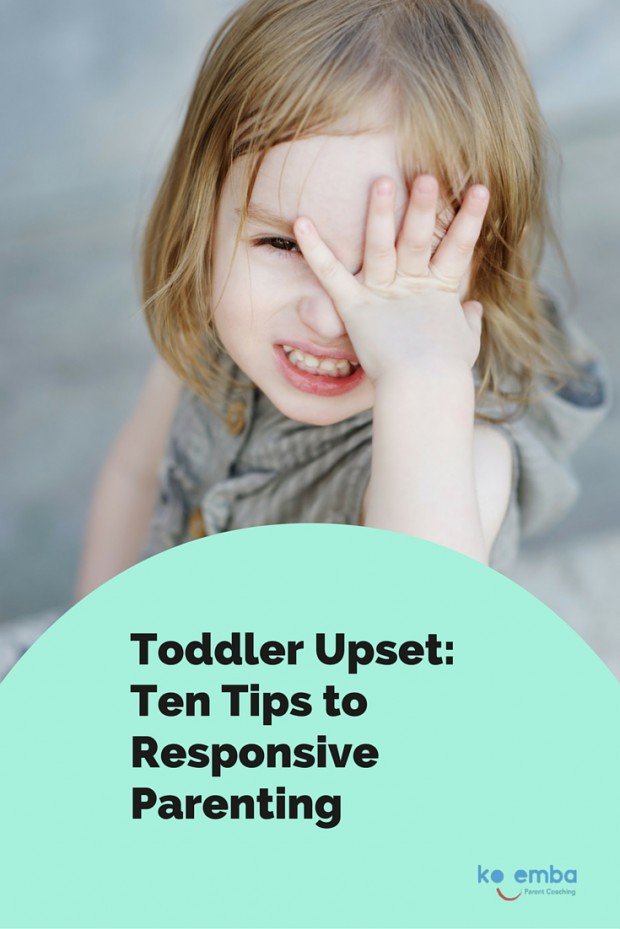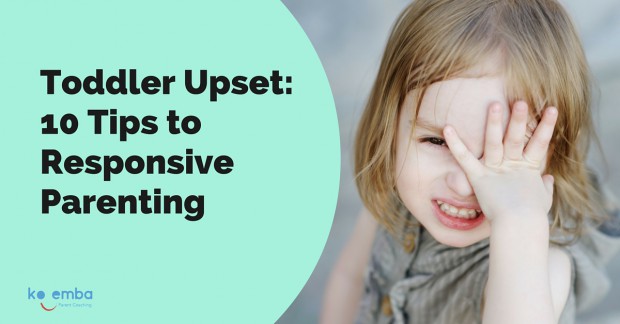The wails of a toddler in distress ricochets off the walls. I glance at the mother, who yanks her crying toddler by the arm, ignoring her wails. The toddler drags behind her, screaming her protest.
The mother stops. Towering over the child she speaks sharply, wagging her finger in the child’s face. Then she marches on, with sobbing child in tow.
We’ve all had parenting moments we’re not proud of. But what can help us do differently? Here are some thoughts for stressed parents on what to do when your toddler acts out. We can handle a child’s challenging behaviour more helpfully when we have insights about how the human brain develops. If you are facing a toddler upset here are ten tips for responsive parenting to calm your child and recreate connection.
I hope you’ll keep reading, even if you have older children, because if we all knew what toddlers need to thrive we’d create environments for:
– happier, healthier children
– children who will be more successful as adults
– a happier, healthier generation.
Understanding A Toddler Upset:
✓ Your toddler’s brain is still “under construction”
This means the toddler cannot reason like an adult. She doesn’t have a concept of time. She doesn’t understand that you have deadlines to keep or chores to complete. Trying to explain your agenda to her when she’s demanding won’t help. Rather, focus on connecting with her.
✓ When your toddler’s upset, she’s emotionally flooded, so she can’t reason
The ‘fight or flight’ part of her brain has now been triggered. She’s not reasoning – so trying to logically explain things to her is only likely to increase her frustration – and yours. First she needs your connection and sympathetic understanding.
✓ The young child cannot self-regulate
In other words, she is physically not able to calm herself down. She might cry to a point of exhaustion and then stop – and that’s very different from the child being calmed. When a child’s experience is ignored until she ‘gives up’, her exhausted body is still overloaded with nasty cortisol! Leaving your baby to cry without giving comfort and attention is tantamount to leaving her in a closed room with toxic paint fumes.[i]
So let’s look at what a parent can do to calm an upset toddler.
Toddler Upset – Ten Tips On How To Calm Your Child:
1. Stay emotionally connected to your child
When she’s upset she’s trying to let you know she needs your support. At times when you child is most challenging tile is when she most probably most needs your love and support.
At these times the young child is emotionally overwhelmed and needs your support to calm her down.
2. Choose to be calm
Get down to her eye level and make eye contact (if she will) with a ‘soft gaze’.Your toddler physically can’t calm herself down when she’s upset – she can’t “self regulate”. Her immature nervous system relies on an adult to calm her. So if you choose to calm yourself, it will help to calm her. Your soft gaze will do far more to calm her than any amount of ‘reasoning’ words.
3. Remember her behaviour is about her – your response is about you
There’s already one immature person having a meltdown. Your job is to remain the calm, collected adult who, rather than reacting, chooses to respond helpfully.
4. Focus on your breathing
When you steady your breathing your steady your thoughts.Remind yourself this is your young child who is distressed and needing support.
If you have a key phrase that reminds you of the sort of parent you choose to be, say this to yourself: for example: ‘calm’, ‘being the adult’, ‘reassure’.
Your steady breathing will also help to steady your child’s breathing.
5. Send a ‘CONNECT’ message through your tone of voice/ body language and your facial expression
Your child senses your motivation far more strongly than she can hear the words you are using. (When you most want to say’ Listen to me’ is when she’s emotionally flooded and it’s impossible for her to listen! In upset times your child’s brain can’t make sense of your words. First she needs to connect with you.
She will learn how to deal with stressful times by what you model.
6. Focus on seeing the situation through her eyes, rather than trying to explain yours
See life from her perspective.
Reflect the same words/ energy / simple phrases that she does.
Focus your attention on connecting with her. It’s helpful to imagine ahead of time, before an upset, how you might respond in a similar scenario. Here’s how I would choose to respond:
Mother: ‘You want the toy.’
Child: ‘I want it!’
Mother: ‘You really want it.’
7. Don’t give her what she’s demanding – just acknowledge what she wants
Just because she “wants” the toy, doesn’t mean she has to have it. But you can still acknowledge her experience. (Think of when you say something like, “I’d love that Porsche.” Just because you express the wish, doesn’t mean you need it explained to you why you can’t have it! ) What anyone of us wants is for someone to acknowledge our experience. So, you can empathetically respond, “You’d love that toy” – but it doesn’t;t mean you have to buy it!
8. If she uses attacking words, like ‘Silly Mummy’ reflect the emotion below her words
For example, you might respond, ‘You’re cross with me.’
9. Give words for your child’s emotions
When we acknowledge emotions, over time your child will learn to ‘name, claim and tame’ her emotions. As we model this, our children will be more able to use reason to deal with emotional upsets – to ‘find words (left brain activation) for strong feelings (right brain activation) instead of moving into primitive discharge of these feelings. (as in tantrum).’[ii]
10. It’s okay for your child to cry
Don’t try to stop the tears, just be compassionately present and ready to connect when your child is ready to do so.When we cry when we’re upset, the tears are chemically different to the tears we cry when we’re peeling an onion. Our ‘upset tears’ contain stress hormones. So having a ‘good cry’ / ‘crying it all out’ makes sense.
 Why Connecting Matters
Why Connecting Matters
When you see an upset toddler it’s helpful to remember that her brain and nervous system are still ‘under construction’. She is reliant on you as parent (or carer) to calm and regulate the strong emotions that are storming her young body. Her crying is trying to communicate to you that she’s especially needing your support right now. She needs you to ‘listen to her behaviour’ ; for more about this, see my blog “My toddler screams when her 4 year old sister ‘bugs’ her!”
Your young child is not out to make your life difficult – she’s doing the best she can.
The bottom line is babies and toddlers need caring, connected parents, particularly in times of emotional stress.
But how to be the calm, connected parent you want to be in times of stress? You can discover more with the three signpost to Mindful Parenting in my new Parenting book, ‘BEHAVE – What To Do When Your Child Won’t’. And if you’re a parent who is really keen to discover the practical tools to a more mindful way of Parenting, you’ll want to sign up now for start-when-good-for-you, return-as-often as-you-wish Online Parenting course.
I recommend Margot Sunderland’s book ‘What Every Parent Needs to Know’. It’s the type of book that you’ll frequently dip into, with chapters on issues such as sleep and bedtimes, behaviour issues, crying and separation. It’s filled with a wealth of knowledge and practical advice, based on scientific fact, about what children need to thrive.
[i] Sunderland Margot at Play Therapy conference in Dublin 2008
[ii] Sunderland Margot ‘The Science of Parenting ‘2006 Dorling Kindersley Limited. London, p. 231



No comments yet.